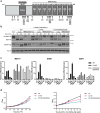Evidence for a hydrogen sulfide-sensing E3 ligase in yeast
- PMID: 39378345
- PMCID: PMC11538405
- DOI: 10.1093/genetics/iyae154
Evidence for a hydrogen sulfide-sensing E3 ligase in yeast
Abstract
In yeast, control of sulfur amino acid metabolism relies upon Met4, a transcription factor that activates the expression of a network of enzymes responsible for the biosynthesis of cysteine and methionine. In times of sulfur abundance, the activity of Met4 is repressed via ubiquitination by the SCFMet30 E3 ubiquitin ligase, but the mechanism by which the F-box protein Met30 senses sulfur status to tune its E3 ligase activity remains unresolved. Herein, we show that Met30 responds to flux through the trans-sulfuration pathway to regulate the MET gene transcriptional program. In particular, Met30 is responsive to the biological gas hydrogen sulfide, which is sufficient to induce ubiquitination of Met4 in vivo. Additionally, we identify important cysteine residues in Met30's WD-40 repeat region that sense the availability of sulfur in the cell. Our findings reveal how SCFMet30 dynamically senses the flow of sulfur metabolites through the trans-sulfuration pathway to regulate the synthesis of these special amino acids.
Keywords: E3 ubiquitin ligase; amino acid; metabolism; nutrients; sensor; sulfur; yeast.
© The Author(s) 2024. Published by Oxford University Press on behalf of The Genetics Society of America.
Conflict of interest statement
Conflicts of interest The authors declare no conflicts of interest.
Figures





Similar articles
-
Multiple inputs control sulfur-containing amino acid synthesis in Saccharomyces cerevisiae.Mol Biol Cell. 2014 May;25(10):1653-65. doi: 10.1091/mbc.E13-12-0755. Epub 2014 Mar 19. Mol Biol Cell. 2014. PMID: 24648496 Free PMC article.
-
Determinants of the ubiquitin-mediated degradation of the Met4 transcription factor.J Biol Chem. 2006 Apr 28;281(17):11744-54. doi: 10.1074/jbc.M600037200. Epub 2006 Feb 23. J Biol Chem. 2006. PMID: 16497670
-
Characterizing the roles of Met31 and Met32 in coordinating Met4-activated transcription in the absence of Met30.Mol Biol Cell. 2012 May;23(10):1928-42. doi: 10.1091/mbc.E11-06-0532. Epub 2012 Mar 21. Mol Biol Cell. 2012. PMID: 22438580 Free PMC article.
-
Proteolytic regulation of metabolic enzymes by E3 ubiquitin ligase complexes: lessons from yeast.Crit Rev Biochem Mol Biol. 2015;50(6):489-502. doi: 10.3109/10409238.2015.1081869. Epub 2015 Sep 11. Crit Rev Biochem Mol Biol. 2015. PMID: 26362128 Review.
-
Metabolism of sulfur amino acids in Saccharomyces cerevisiae.Microbiol Mol Biol Rev. 1997 Dec;61(4):503-32. doi: 10.1128/mmbr.61.4.503-532.1997. Microbiol Mol Biol Rev. 1997. PMID: 9409150 Free PMC article. Review.
Cited by
-
Mechanisms and rationales of SAM homeostasis.Trends Biochem Sci. 2025 Mar;50(3):242-254. doi: 10.1016/j.tibs.2024.12.009. Epub 2025 Jan 15. Trends Biochem Sci. 2025. PMID: 39818457 Review.
-
Distinct Stress Regulators in the CRL Family: Emerging Roles of F-Box Proteins: Cullin-RING Ligases and Stress-Sensing.Bioessays. 2025 May;47(5):e202400249. doi: 10.1002/bies.202400249. Epub 2025 Mar 16. Bioessays. 2025. PMID: 40091294 Review.
References
MeSH terms
Substances
Grants and funding
LinkOut - more resources
Full Text Sources
Miscellaneous

